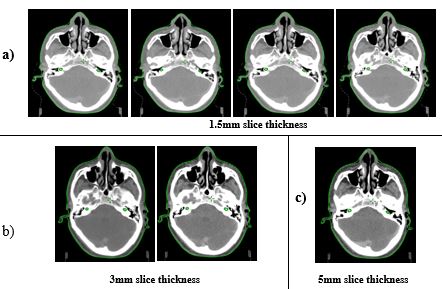Volumetric and dosimetric effects of different slice thickness in radiotherapy planning Computed Tomography for head and Neck cancer
Abstract
Introduction: Accurate estimation of target and Organ at Risk Volume is required to ensuretreatment efficacy and minimal normal tissue toxicity in radiotherapy planning. ComputedTomography slice thickness plays a vital role in volume estimation. It highly impacts smaller volumeorgans such as 1-3cm3.
Materials and Methods: CT datasets of 20 head and neck cancer patientswere recruited for this study in each CT data three CT series with a slice thickness of 1.5mm, 3mmand 5mm were imported to the TPS. Eclipse TPS of version 13.6 was used for delineation andtreatment planning.
Results: The variability of volumes with CT slice thickness was significant,especially for small volume structures. The maximum volume error of 63% was found in >3ccvolume structures with 5mm slice thickness. Whereas in larger volume structures the differenceswere observed 2%in terms of volume and mean dose. And in terms of homogeneity and conformity,there is no significant difference was found.
Conclusion: This study concludes that for head andneck cancer which has many smaller volume structures 1.5mm slice thickness will accuratelyestimate the volume which is clinically useful for OAR near the PTV.
Downloads
References
2. S.P. Srivastava, C.W. Chen, I.J. Das.The effect of slice thickness on target and organs at risk volumes, dosimetric coverage and ragiobiological impact in IMRT planning. Springer.
3.Ramachandran Prabhakar, Ph.D., Tharmar Ganesh, Ph.D., Goura K. Rath, M.D.,
Pramod K. Julka, M.D., Pappiah S. Sridhar, M.D., Rakesh C. Joshi, Ph.D., And
Sanjay Thulkar, M.D. Impact Of Different CT Slice Thickness On Clinical Target Volume For 3d Conformal Radiation Therapy. Med Dosim. 2009;34:36-41.
4. C Olsson, M Thor, M Liu, V Moissenko, S E Petersen, M Høyer, A Apte and J O Deasy. Influence of image slice thickness on rectal dose–response relationships following radiotherapy of prostate cancer. Phys Med Biol. 2014;59(14):3749-3759.
5. Z. Alirezaei, A.R. Amouheidari, I. Abedi, F. Davanian, P. Shokrani*, M.R. Nazemzadeh. Optimization of CT slice thickness in 3D-CRT and IMRT planning of low grade glioma. International journal of radiation research. 2021 volume19.

Copyright (c) 2022 Author (s). Published by Siddharth Health Research and Social Welfare Society

This work is licensed under a Creative Commons Attribution 4.0 International License.


 OAI - Open Archives Initiative
OAI - Open Archives Initiative


